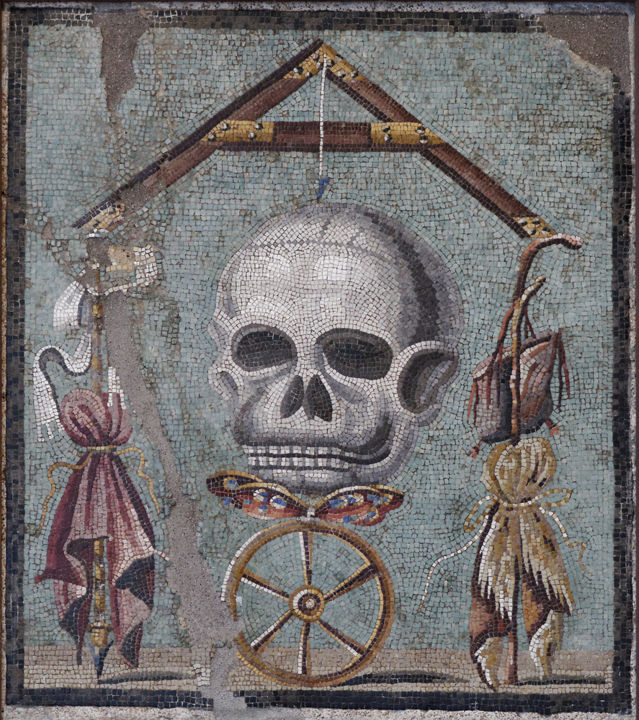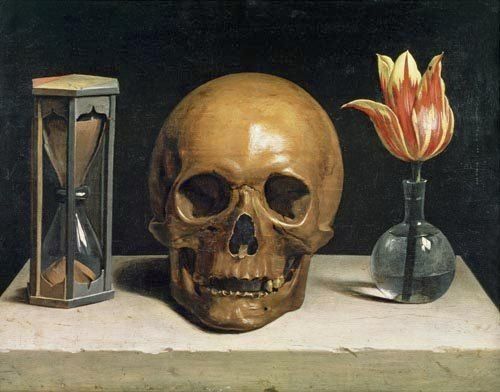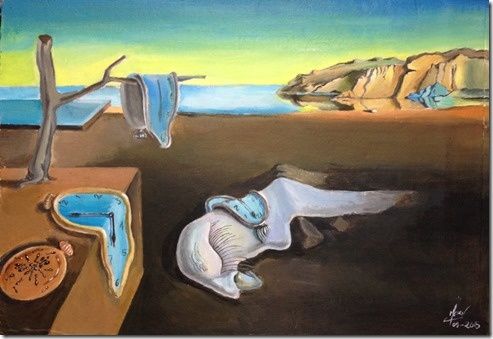While we will be like every year invited to our clocks back an hour this Saturday, major art the opportunity to r offers a return on these works that managed to represent the time elapsed so impalpable and inexorable.
Memento mori, mosaic from Pompeii, 1st century BC

Memento mori, polychrome mosaic from Pompeii, 1st century, National Archaeological Museum of Naples © Archives special superintendent Beni and archologici Naples and Pompei
Among the oldest Memento mori , these representations that remind us that every man must die one day, we must certainly mention this famous mosaic found in Pompeii and which is now kept in the Archaeological Museum of Naples. This kind of composition will be taken up both in the Middle Ages and, in a more refined way, in the Baroque period with the painting of "vanities" . The work is easy to read because the symbols have remained in a very good state of conservation for about two millennia thanks to archaeological recovery. The wheel here symbolizes luck. It rotates as long as humans are alive and can interact with it, whether by chance or through their own actions. She directs the course of existence towards wealth represented by the beautiful coat on the left, or towards poverty with a wanderer's outfit on the right. When death (symbolized here by the skull) arrives, the wheel stops and then nothing has any more value. The notions of wealth and poverty then lose all meaning. The mosaic comes from a Roman triclinium (a dining room) of a Pompeian house, where meals were taken. A way of reminding the owner and the guests to remain humble as mere mortals, and not to leave their fate to chance.
Philippe de Champaigne (1602-1674), Vanity.

Philippe de Champaigne Vanité, oil on wood, 28 cm x 37 cm, Tessé museum, Le Mans
At the very beginning of the 17th century, paintings of a new genre appeared, the Vanities . This name takes its root from the term "vain", which refers to what is empty, illusory. These are paintings classified in the genre of still lifes, and contain a set of emblems and objects whose possession seems futile, derisory as in the work shown above by Philippe de Champaigne (1602-1674), Vanité . Among the most common character-defining elements are the skull, the extinguished candle, or the silence of musical instruments as symbols of death. The hourglass or the clock, as symbols of the passage of time, but also soap bubbles symbolizing both the fleetingness of life and earthly goods. A faded flower , like a tulip or a rose, reflecting the image of life that will end sooner or later.
The Three Ages of Man - Giorgione

The Three Ages of Man, c.1500-01 (panel) - Giorgione da Castelfranco, Palazzo Pitti, Florence, Italy
The theme of time has also often been approached in painting from the angle of the different ages of man, to which many paintings are devoted. Let us take the example of the painting by the Italian painter Giorgione : “ The three ages of man ”. This work represents three male figures. In the center a young man holding a sheet of music, on the right an adult who speaks to him while showing the score, on the left an old man who, from behind, turns to look at the spectator. The figures slowly emerge from the background, highlighted in shaded colors. Today the subject of the painting is still very much debated. All of Giorgione's canvases hide a second level of meaning, often obscure: this singing lesson is probably an allegory and an intimate reflection on the flow of existence, in which it is important to pass the baton on to future generations before it is not too late, as the melancholy gaze of the old man confirms, attracting the viewer's attention.
Salvador Dali's “The Persistence of Memory”
 Salvador Dali's “The Persistence of Memory” The Museum of Modern Art, New York
Salvador Dali's “The Persistence of Memory” The Museum of Modern Art, New York
The persistence of memory is one of Salvador Dalì's most memorable paintings. As a characteristic element of the work we find the famous cast clocks. Dalì explained how he got this inspiration. The artist found himself watching a slice of cheese melt in the sun. This vision inspired him with the idea of the clocks that he immediately painted on the canvas. The image he painted was of a landscape in Port Lligat , Spain, where he was living with his wife Gala at the time of the work. Some unreal objects are arranged in a fantastic landscape. A few clocks with a distorted texture dominate the scene. Moles show which still mark time, but seem to have lost their solidity. One can imagine that molten clocks represent the relativity of temporal perception. Each of us, in fact, has our own temporal sensation in relation to the same situations. In addition, each clock displays different times. Note also the presence of black ants on a watch in the foreground, a common image signifying the decomposition linked to time, and evoking a fear of death.
Roman OPALKA: OPALKA 1965/1 - ∞

OPALKA Roman (1931-2011), OPALKA 1965/1-∞, Detail 1-35327 , detail, 1965, - acrylic on canvas, 196x135 cm.
In 1965, while he was waiting for his wife, Roman Opalka had an idea that would guide his creation for forty-six years. On canvases measuring 196x135 cm, he exhausted himself relentlessly inscribing digital progression. The numbers are about 5mm high, painted with a size 0 brush. He started painting white on a black background and from 1972 he added 1% white to each background of new canvases. In 2008 came the moment when he logically ended up painting white on white. He called it the " deserved white " ... This work is the result of an artistic energy dedicated to the search for the truest representation of the concept of time, in art. The Polish painter was deeply concerned with the material capture of the intangible. His work reflects a lifetime of reflection on the best way to distill "time" in physical form. OPALKA 1965/1 - ∞, therefore constitutes an innovative proposal for the representation of temporal and aesthetic questions.
Melting Men: Néle Azevedo

"Minimum Monument" also better known under the name of " Melting Men ", is an idea born in 2002 in the mind of the Brazilian artist Néle Azevedo . A traveling and ephemeral artistic installation made up of thousands of small ice sculptures. A representation of men of ice melting in the sun, seated on the steps of monuments in the most beautiful cities in the world. The installation was indeed presented in Brasilia , in Tokyo , then in Belfast and also in Florence in 2008 with 1200 ice sculptures arranged on the steps of the Spedale degli Innocenti . Melting Men is a work whose original intentions were to represent a contrast between the eternity of official art represented by the monuments on which the sculptures were arranged, in relation to the ephemeral aspect of contemporary art. A work playing on different levels of contrasts as on the tiny size of the sculptures, or their materials of composition: ice. However, the work was immediately taken up by environmental associations who made it their symbol, associating it with a critical reflection on climate change and the melting ice in the Arctic.
The passing of time, a subject that speaks to you? Find our selection of works that evoke this concept on Artmajeur.

